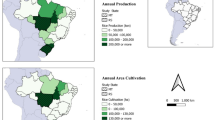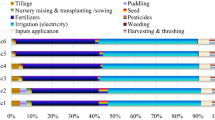Abstract
The status of energy balance and energy economics of irrigated and rain-fed rice production systems is studied and compared for highlighting the effect of farm size. Primary data were collected from 51 irrigated and 54 rain-fed rice farms in Northern Ayeyarwaddy Region, Myanmar. Farm classes were identified as small (<2.5 ha) and large (2.5–25 ha). Energy estimates were calculated from actual amount of inputs and outputs and corresponding conversion factors. Results showed that the total energy inputs were 19,170.5 and 11,031.1 MJ/ha, respectively, in irrigated and rain-fed rice systems, while the total energy outputs were 104,162.7 and 65,033.5 MJ/ha in the two systems, respectively. Energy efficiency ratios, defined as output-to-input energy values, were 5.6 and 5.9 in irrigated and rain-fed rice production systems. Interestingly, the two systems were not statistically different for their energy efficiencies. Similarly, the energy efficiency ratios for different farm classes under both rice production systems were also not statistically different. Energy productivity and specific energy were 0.27 and 3.8 kg/MJ; 0.29 and 3.9 MJ/kg in irrigated and rain-fed systems, respectively. The energy benefit–cost ratio was higher in rain-fed rice (1.1) than in irrigated rice (0.9) system. Rain-fed system seems to have potential of further increasing yield through the increased yet appropriate use of energy inputs.









Similar content being viewed by others
References
AghaAlikhani, M., Kazemi-Poshtmasari, H., & Habibzadeh, F. (2013). Energy use pattern in rice production: a case study from Mazandaran province, Iran. Energy Conversion and Management, 69, 157–162.
Asian Development Bank. (2013). Asian development outlook 2013: Asia’s energy challenge. Philippines: Asian Development Bank.
Bautista, E. G., & Miniwa, T. (2010). Analysis of the energy for different rice production systems in the Philippines. The Philippine Agricultural Scientist, 93(3), 346–357.
Bockari-Gevao, S. M., Wan Ishak, W. I., Azmi, Y., & Cahn, C. W. (2005). Analysis of energy consumption in lowland rice-based cropping system of Malaysia. Songklanakarin Journal of Science and Technology, 27(4), 819–826.
Cervinka, V. (1980). Fuel and energy efficiency. In D. Pimentel (Ed.), Handbook of energy utilization in agriculture (pp. 15–21). Boca Raton: CRC Press.
Chamsing, A., Salokhe, V. M., & Singh, G. (2006). Energy consumption analysis for selected crops in different regions of Thailand. Agricultural Engineering International: The CIGR E Journal, 2006, 8.
Cicek, A., Altintas, G., & Erdal, G. (2011). Energy consumption patterns and economic analysis of irrigated wheat and rain-fed wheat production: case study for Tokat Region, Turkey. Bulgarian Journal of Agricultural Science, 17(3), 378–388.
Dapice, D.O. (2011). Myanmar Agriculture in 2011: old problems and new challenges, Ash Center for Democratic Governance and Innovation, Harard Kennedy School.
Esengun, K., Gunduz, O., & Erdal, G. (2007). Input-output energy analysis in dry apricot production of Turkey. Energy Coversion and Management, 48, 592–598.
FAO. (2009). Food security and agricultural mitigation in developing countries: options for capturing synergies. Rome: Food and Agriculture Organization.
Heidari, M. D., & Omid, M. (2011). Energy use patterns and econometric models of major greenhouse vegetable production in Iran. Energy, 36(1), 220–225.
Khan, M. A., Khan, S., & Mushtaq, S. (2009a). Energy and economic efficiency analysis of rice and cotton production in China. Sarhad Journal of Agriculture, 25(2), 291–300.
Khan, M. A., Awan, I. U., & Zafar, J. (2009b). Energy requirement and economic analysis of rice production in western part of Pakistan. Soil and Environmental, 28(1), 60–67.
Kuswardhani, N., Soni, P., & Shivakoti, G. P. (2013). Comparative energy input-output and financial analyses of greenhouse and open field vegetables production in West Java, Indonesia. Energy, 53, 83–92.
Kyung-Ryang, K., & Abafita, J. (2014). Agricultural development in Myanmar: lessons from Korean experience. Korean Journal of International Agriculture, 24(2), 136–151.
MOAI. (2012). Annual report of ministry of agriculture and irrigation. Nay Pyi Taw: Department of Agriculture.
Myo, K.M. (2012). An assessment of soil salinity problems, its impact on rice cultivation and coping strategies of local farmers: a case study in Pyopon Township, Ayeyarwaddy Delta Region, Myanmar after Cyclone Nargis. Master Thesis, Asian Institute of Technology.
Nassiri, S. M., & Singh, S. (2009). Study on energy use efficiency for paddy crop using data envelope analysis (DEA) technique. Applied Energy, 86, 1320–1325.
Ozkan, B., Akcaoz, H., & Fert, C. (2004). Energy input output analysis in Turkish agriculture. Renewable Energy, 29(1), 39–51.
Ozkan, B., Ceylan, R. F., & Kizilay, H. (2011a). Energy input and crop yield relationships in greenhouse winter crop tomato production. Renewable Energy, 36(11), 3217–3221.
Ozkan, B., Ceylan, R. F., & Kizilay, H. (2011b). Comparison of energy inputs in glasshouse double crop (fall and summer crops) tomato production. Renewable Energy, 36(5), 1639–1644.
Prasannakumar, P. S., & Hugar, L. B. (2011). Economic analysis of energy use in paddy cultivation under irrigated situation. Karnataka Journal of Agricultural Science, 24(4), 467–470.
Sandrine, R. (2008). Water, sanitation & hygiene disaster risk reduction assessment, Ayeyarwaddy Division. Action Contre La Faim- Mission Myanmar Report.
Singh, S., & Mittal, J. P. (1992). Energy in production agriculture. New Delhi: Mittal Publications.
Singh, H., Mishra, D., & Nahar, N. M. (2002). Energy use pattern in production agriculture of a typical village in arid zone India: part I. Energy Conversion and Management, 43(16), 2275–2286.
Singh, G., Singh, S., & Singh, J. (2004). Optimization of energy inputs for wheat crop in Punjab. Energy Conversion and Management, 45(3), 453–465.
Soni, P., Taewichit, C., & Salokhe, V. M. (2013). Energy consumption and CO2 emissions in rain-fed agricultural production systems of Northeast Thailand. Agricultural Systems, 116(1), 25–36.
Taewichit, C. (2012). Multiple criteria decision making in integrated agricultural production systems under Thai rain-fed condition. PhD Dissertation, Asian Institute of Technology, Thailand.
Ullah, A. (2009). A comparative analysis of energy use patterns in small and large scale irrigated rice farming systems: a case study in Ayutthaya Province in the central region of Thailand. Master Thesis, Asian Institute of Technology, Thailand.
USDA. (2012). Impacts of higher energy prices on agriculture and rural economies, United States Department of Agriculture.
Zaw, K., Lwin, N., Nyein, K., & Thandar, M. (2011). Agricultural transformation, institutional changes, rural development in Ayeyarwaddy delta, Myanmar. Economic Research Institute for ASEAN and East Asia(ERIA).
Acknowledgments
The authors gratefully acknowledge the support received from the Norwegian Ministry of Foreign Affairs, the Asian Institute of Technology, and the farmers of Myanmar.
Author information
Authors and Affiliations
Corresponding author
Rights and permissions
About this article
Cite this article
Soni, P., Soe, M.N. Energy balance and energy economic analyses of rice production systems in Ayeyarwaddy Region of Myanmar. Energy Efficiency 9, 223–237 (2016). https://doi.org/10.1007/s12053-015-9359-x
Received:
Accepted:
Published:
Issue Date:
DOI: https://doi.org/10.1007/s12053-015-9359-x




